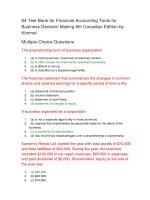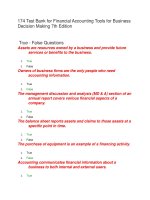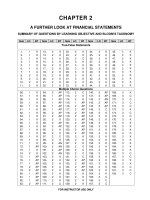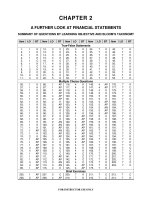Test bank for financial accounting tools for business decision making 6th edition
Bạn đang xem bản rút gọn của tài liệu. Xem và tải ngay bản đầy đủ của tài liệu tại đây (263.79 KB, 47 trang )
Test Bank for Financial Accounting Tools for Business Decision
Making 6th Edition
A business organized as a separate legal entity owned by stockholders is a
partnership.
1. True
2. False
Corporate stockholders generally pay higher taxes but have no personal
liability.
1. True
2. False
The liability of corporate stockholders is limited to the amount of their
investment.
1. True
2. False
The majority of U.S. business is transacted by proprietorships.
1. True
2. False
Proprietorships in the United States generate more revenue than the other
two forms of business enterprise.
1. True
2. False
Owners of business firms are the only people who need accounting
information.
1. True
2. False
Management of a business enterprise is the major external user of
information.
1. True
2. False
External users of accounting information are managers who plan, organize,
and run a business.
1. True
2. False
The information needs and questions of external users vary considerably.
1. True
2. False
Accounting communicates financial information about a business to both
internal and external users.
1. True
2. False
Two primary external users of accounting information are investors and
creditors.
1. True
2. False
Financing activities for corporations include borrowing money and selling
shares of their own stock.
1. True
2. False
Investing activities involve collecting the necessary funds to support the
business.
1. True
2. False
The purchase of equipment is an example of a financing activity.
1. True
2. False
Assets are resources owned by a business and provide future services or
benefits to the business.
1. True
2. False
Payments to owners are operating activities.
1. True
2. False
The economic resources that are owned by a business are called
stockholders’ equity.
1. True
2. False
Operating activities involve putting the resources of the business into action
to generate a profit.
1. True
2. False
A business is usually involved in two types of activity—financing and
investing.
1. True
2. False
Net income for the period is determined by subtracting total expenses and
dividends from revenues.
1. True
2. False
A different set of financial statements usually is prepared for each user.
1. True
2. False
The heading for the income statement might include the line “As of December
31, 20xx.”
1. True
2. False
Net income is another term for revenue.
1. True
2. False
Cash is another term for Stockholders’ Equity.
1. True
2. False
The primary purpose of the statement of cash flows is to provide information
about the cash receipts and cash payments of a company for a specific period
of time.
1. True
2. False
The balance sheet reports assets and claims to those assets at a specific
point in time.
1. True
2. False
The basic accounting equation states that Assets = Liabilities.
1. True
2. False
One way of stating the accounting equation is: Assets + Liabilities =
Stockholders’ Equity.
1. True
2. False
The accounting equation can be expressed as Assets - Stockholders’ Equity =
Liabilities.
1. True
2. False
The accounting equation can be expressed as Assets - Liabilities =
Stockholders’ Equity.
1. True
2. False
If the assets owned by a business total $150,000 and liabilities total
$105,000, stockholders’ equity totals $45,000.
1. True
2. False
If the assets owned by a business total $100,000 and liabilities total $65,000,
stockholders’ equity totals $25,000.
1. True
2. False
Claims of creditors and owners on the assets of a business are called
liabilities.
1. True
2. False
Creditors’ rights to assets supersede owners’ rights to the assets.
1. True
2. False
All publicly traded U.S. companies must provide their shareholders with an
annual report each year.
1. True
2. False
Information in the notes to the financial statements has to be quantifiable
(numeric).
1. True
2. False
An auditor is an accounting professional who conducts an independent
examination of the accounting data presented by a company.
1. True
2. False
The management discussion and analysis (MD & A) section of an annual
report covers various financial aspects of a company.
1. True
2. False
Explanatory notes and supporting schedules are an optional part of an annual
report.
1. True
2. False
Examples of notes are descriptions of the significant accounting policies and
methods used in preparing the statements, explanations of contingencies,
and various statistics.
1. True
2. False
Liabilities of a company are owed to
1. a. debtors.
2. b. owners.
3. c. creditors.
4. d. stockholders.
Stockholders’ equity can be described as claims of
1. a. creditors on total assets.
2. b. owners on total assets.
3. c. customers on total assets.
4. d. debtors on total assets.
Payments to stockholders are called
1. a. expenses.
2. b. liabilities.
3. c. dividends.
4. d. distributions.
Common stock is reported on the
1. a. statement of cash flows.
2. b. retained earnings statement.
3. c. income statement.
4. d. balance sheet.
Stockholders’ equity is comprised of
1. a. common stock and dividends.
2. b. common stock and retained earnings.
3. c. dividends and retained earnings.
4. d. net income and retained earnings.
Stockholders’ equity
1. a. is usually equal to cash on hand.
2. b. is equal to liabilities and retained earnings.
3. c. includes retained earnings and common stock.
4. d. is shown on the income statement.
Retained earnings is
1. a. the stockholders’ claim on total assets.
2. b. equal to cash.
3. c. equal to revenues.
4. d. the amount of net income kept in the corporation for future use.
Which financial statement would best indicate whether the company relies on
debt or stockholders’ equity to finance its assets?
1. a. Statement of Cash Flows
2. b. Retained Earnings Statement
3. c. Income Statement
4. d. Balance Sheet
The primary purpose of the statement of cash flows is to report
1. a. a company`s investing transactions.
2. b. a company`s financing transactions.
3. c. information about cash receipts and cash payments of a company.
4. d. the net increase or decrease in cash.
Claims of owners are called
1. a. dividends
2. b. stockholders’ equity
3. c. liabilities
4. d. income payable
Which of the following is not a common way that managers use the balance
sheet?
1. a. To analyze the balances of assets, liabilities, and stockholders’ equity
throughout the accounting period
2. b. To determine if the cash balance is sufficient for future needs
3. c. To analyze the balance between debt and common stock financing
4. d. To analyze the balance of accounts receivable on the last day of the
accounting period
Why are financial statement users interested in the statement of cash
flows?
1. a. It is the easiest financial statement to evaluate.
2. b. It provides information about an important company resource.
3. c. It is the first statement that is presented to users.
4. d. It helps users decide whether assets such as office equipment should be
replaced.
Why should the income statement be prepared first?
1. a. The statement of cash flows should be prepared first because it determines
the sources of cash. That information is then used in preparing the income
statement.
2. b. Net income from the income statement flows into the retained earnings
statement. The ending retained earnings balance then flows into the balance
sheet.
3. c. The income statement does not have to be prepared first. Financial
statements can be prepared in any order.
4. d. None of these statements is correct.
Elston Company compiled the following financial information as of December
31, 2012: Revenues $420,000 Common stock 90,000 Equipment 120,000
Expenses 375,000 Cash 105,000 Dividends 30,000 Supplies 15,000 Accounts
payable 60,000 Accounts receivable 45,000 Retained earnings, 1/1/12 225,000
Elston’s assets on December 31, 2012 are:
1. a. $705,000
2. b. $510,000
3. c. $240,000
4. d. $285,000
Elston Company compiled the following financial information as of December
31, 2012: Revenues $420,000 Common stock 90,000 Equipment 120,000
Expenses 375,000 Cash 105,000 Dividends 30,000 Supplies 15,000 Accounts
payable 60,000 Accounts receivable 45,000 Retained earnings, 1/1/12 225,000
Elston’s retained earnings on December 31, 2012 are:
1. a. $225,000
2. b. $270,000
3. c. $240,000
4. d. $ 15,000
Elston Company compiled the following financial information as of December
31, 2012: Revenues $420,000 Common stock 90,000 Equipment 120,000
Expenses 375,000 Cash 105,000 Dividends 30,000 Supplies 15,000 Accounts
payable 60,000 Accounts receivable 45,000 Retained earnings, 1/1/12 225,000
Elston’s stockholders’ equity on December 31, 2012 is:
1. a. $315,000
2. b. $330,000
3. c. $240,000
4. d. $360,000
Benedict Company compiled the following financial information as of
December 31, 2012: Revenues $280,000 Common stock 60,000 Equipment
80,000 Expenses 250,000 Cash 70,000 Dividends 20,000 Supplies 10,000
Accounts payable 40,000 Accounts receivable 30,000 Retained earnings,
1/1/12 150,000 Benedict’s assets on December 31, 2012 are:
1. a. $470,000
2. b. $340,000
3. c. $160,000
4. d. $190,000
Benedict Company compiled the following financial information as of
December 31, 2012: Revenues $280,000 Common stock 60,000 Equipment
80,000 Expenses 250,000 Cash 70,000 Dividends 20,000 Supplies 10,000
Accounts payable 40,000 Accounts receivable 30,000 Retained earnings,
1/1/12 150,000 Benedict’s retained earnings on December 31, 2012 are:
1. a. $150,000
2. b. $180,000
3. c. $160,000
4. d. $ 10,000
Benedict Company compiled the following financial information as of
December 31, 2012: Revenues $280,000 Common stock 60,000 Equipment
80,000 Expenses 250,000 Cash 70,000 Dividends 20,000 Supplies 10,000
Accounts payable 40,000 Accounts receivable 30,000 Retained earnings,
1/1/12 150,000 Benedict’s stockholders’ equity on December 31, 2012 is:
1. a. $210,000
2. b. $220,000
3. c. $160,000
4. d. $240,000
The heading on the statement of cash flows identifies all of the following
except:
1. a. the preparer of the statement
2. b. the company
3. c. the time period covered by the statement
4. d. the type of statement
All of the following are interrelationships that are important to understand
when preparing financial statements except:
1. a. The net income from the income statement is used in the retained earnings
statement.
2. b. The ending retained earnings from the Retained earnings statement is
used in the stockholder`s equity section of the balance sheet.
3. c. The cash on the balance sheet should be equal to the cash at the end of
the period on the statement of cash flows.
4. d. All of the payments on the balance sheet should be equal to the cash
payments for operating activities on the statement of cash flows.
Marvin Services Corporation had the following accounts and balances:
Accounts payable $12,000 Equipment $14,000 Accounts receivable 2,000 Land
14,000 Buildings ? Unearned service revenue 4,000 Cash 6,000 Total
stockholders' equity ? If the balance of the Buildings account was $28,000
and $2,000 of Accounts Payable were paid in cash, what would be the balance
of the total stockholders' equity?
1. a. $54,000
2. b. $48,000
3. c. $68,000
4. d. $52,000
Marvin Services Corporation had the following accounts and balances:
Accounts payable $12,000 Equipment $14,000 Accounts receivable 2,000 Land
14,000 Buildings ? Unearned service revenue 4,000 Cash 6,000 Total
stockholders' equity ? If the balance of the Buildings account was $16,000
and $4,000 of Accounts Payable were paid in cash, what would be the total
liabilities and stockholders' equity?
1. a. $36,000
2. b. $52,000
3. c. $32,000
4. d. $48,000
Marvin Services Corporation had the following accounts and balances:
Accounts payable $12,000 Equipment $14,000 Accounts receivable 2,000 Land
14,000 Buildings ? Unearned service revenue 4,000 Cash 6,000 Total
stockholders' equity ? If total stockholder's equity was $38,000, what would
be the balance of the Buildings Account?
1. a. $14,000
2. b. $54,000
3. c. $58,000
4. d. $18,000
Marvin Services Corporation had the following accounts and balances:
Accounts payable $12,000 Equipment $14,000 Accounts receivable 2,000 Land
14,000 Buildings ? Unearned service revenue 4,000 Cash 6,000 Total
stockholders' equity ? If the balance of the Buildings account was $30,000
and the equipment was sold for $14,000, what would be the total of
stockholders' equity?
1. a. $26,000
2. b. $36,000
3. c. $46,000
4. d. $50,000
Marvin Services Corporation had the following accounts and balances:
Accounts payable $12,000 Equipment $14,000 Accounts receivable 2,000 Land
14,000 Buildings ? Unearned service revenue 4,000 Cash 6,000 Total
stockholders' equity ? If the balance of the Buildings account was $34,000,
what would be the total of liabilities and stockholders' equity?
1. a. $68,000
2. b. $70,000
3. c. $54,000
4. d. $50,000
Notes to the financial statements include all of the following except:
1. a. Descriptions of significant accounting policies used.
2. b. Explanations of uncertainties.
3. c. Quantifiable accounting information.
4. d. Statistics needed to understand the statements.
The management discussion and analysis (MD&A) section of the annual report
covers all of the following aspects except:
1. a. The ability of the company to pay near-term obligations.
2. b. The certification criteria of the company`s auditors.
3. c. The company`s ability to fund operations and expansion.
4. d. The results of the company operations.
An annual report includes all of the following except
1. a. management discussion and analysis section.
2. b. notes to the financial statements.
3. c. an auditor’s report.
4. d. salary information for all the executives.
Which of the following clarifies information presented in the financial
statements, as well as expanding upon it where additional detail is
needed?
1. a. Auditor’s report
2. b. Management discussion and analysis section
3. c. Notes to the financial statements
4. d. President’s state of the company report
The information needed to determine whether a company is using accounting
methods similar to those of its competitors would be found in the
1. a. auditor’s report.
2. b. balance sheet.
3. c. management discussion and analysis section.
4. d. notes to the financial statements.
In the annual report, where would a financial statement reader find out if the
company’s financial statements give a fair depiction of its financial position
and operating results?
1. a. Notes to the financial statements
2. b. Management discussion and analysis section
3. c. Balance sheet
4. d. Auditor’s report
Management’s views on the company’s short-term debt paying ability,
expansion financing, and results of operations are found in the
1. a. auditor’s report.
2. b. management discussion and analysis section.
3. c. notes to the financial statements.
4. d. president’s state of the company report.
Which of the following statements is true?
1. a. Publicly traded U.S. companies must provide an annual report to their
shareholders when operating conditions change significantly.
2. b. An unqualified independent auditor’s report must be included in the annual
report.
3. c. Notes to the financial statements do not need to be included in the annual
report because that information is only for internal users.
4. d. All of the statements are false.
Notes to the financial statements
1. a. are optional.
2. b. help clarify information presented in the financial statements.
3. c. are generally brief and few in number.
4. d. need not be read in detail if an unqualified opinion accompanies the
financial statements.
The proprietorship form of business organization
1. a. must have at least two owners in most states.
2. b. generally receives favorable tax treatment relative to a corporation.
3. c. combines the records of the business with the personal records of the
owner.
4. d. is classified as a separate legal entity.
A business organized as a corporation
1. a. is not a separate legal entity in most states.
2. b. requires that stockholders be personally liable for the debts of the
business.
3. c. is owned by its stockholders.
4. d. has tax advantages over a proprietorship or partnership.
The partnership form of business organization
1. a. is a separate legal entity.
2. b. is a common form of organization for service-type businesses.
3. c. enjoys an unlimited life.
4. d. has limited liability.
Which of the following is not one of the three forms of business
organization?
1. a. corporations.
2. b. partnerships.
3. c. proprietorships.
4. d. investors.
Most business enterprises in the United States are
1. a. proprietorships and partnerships.
2. b. partnerships.
3. c. corporations.
4. d. government units.
A business organized as a separate legal entity is a
1. a. corporation.
2. b. proprietor.
3. c. government unit.
4. d. partnership.
Which of the following is not an advantage of the corporate form of business
organization?
1. a. No personal liability
2. b. Easy to transfer ownership
3. c. Favorable tax treatment
4. d. Easy to raise funds
An advantage of the corporate form of business is that
1. a. it has limited life.
2. b. its owner’s personal resources are at stake.
3. c. its ownership is easily transferable via the sale of shares of stock.
4. d. it is simple to establish.
Which of the following is an advantage of corporations relative to
partnerships and sole proprietorships?
1. a. Reduced legal liability for investors.
2. b. Harder to transfer ownership.
3. c. Lower taxes.
4. d. Most common form of organization.
A corporation has which of the following set of characteristics?
1. a. Shared control, tax advantages, increased skills and resources
2. b. Simple to set up and maintains control with founder
3. c. Easier to transfer ownership and raise funds, no personal liability
4. d. Harder to raise funds and gives owner control
A small neighborhood barber shop that is operated by its owner would likely
be organized as a
1. a. joint venture.
2. b. partnership.
3. c. corporation.
4. d. proprietorship.
A local retail shop has been operating as a sole proprietorship. The business
is growing and now the owner wants to incorporate. Which of the following is
not a reason for this owner to incorporate?
1. a. ability to raise capital for expansion
2. b. desire to limit the owner’s personal liability
3. c. the prestige of operating as a corporation
4. d. the ease in transferring shares of the corporation’s stock
All of the following are advantages for choosing a proprietorship for a
business except:
1. a. A proprietorship is a simple form of business to set up.
2. b. A proprietorship gives the owner control of the business.
3. c. Proprietorship receive more favorable tax treatment.
4. d. Transfer of ownership is easily achieved through stock sales.
Jack and Jill form a partnership. Jack runs the business in New York, while Jill
vacations in Hawaii. During the time Jill is away from the business, Jack
increases the debts of the business by $20,000. Which of the following
statements is true regarding this debt?
1. a. Only Jack is personally liable for the debt, since he has been the managing
partner during that time.
2. b. Only Jill is personally liable for the debt of the business, since Jack has
been working and she has not.
3. c. Both Jack and Jill are personally liable for the business debt.
4. d. Neither Jack nor Jill is personally liable for the business debt, since the
partnership is a separate legal entity.
Which one of the following questions is most likely asked by an internal
human resources director for the company?
1. a. Which product line is most profitable?
2. b. What price for our product will maximize the company income?
3. c. What average pay raise is affordable for employees this year?
4. d. Should any product lines be eliminated?
Which of the following are internal reports that accounting provides to
internal users?
1. a. Forecasts of cash needs for next year.
2. b. Financial comparisons of operating activity alternative.
3. c. Both a and b are internal reports.
4. d. Neither a or b is an internal report.
Which of the following is the best definition of an internal user of accounting
information?
1. a. Investors who use accounting information to decide whether to buy or sell
stock.
2. b. Creditors like banks that use accounting information to evaluate the risk of
lending money.
3. c. Labor unions who use accounting information to examine the ability of the
company to pay increased wages and benefits.
4. d. Managers who use accounting information to plan, organize, and run a
business.
External users of accounting information, like the Internal Revenue Service,
are most commonly known as:
1. a. taxing authorities
2. b. labor unions
3. c. customers
4. d. regulatory agencies
Which of the following statements is not true regarding the Sarbanes-Oxley
Act (SOX) of 2002?
1. a. The Act calls for increased oversight responsibilities for boards of directors.
2. b. The Act has resulted in increased penalties for financial fraud by top
management.
3. c. The Act calls for decreased independence of outside auditors reviewing
corporate financial statements.
4. d. The Act is meant to decrease the likelihood of unethical corporate
behavior.
Which of the following is not a step for solving an ethical dilemma?
1. a. Identifying the alternatives and weighing the impact of each alternative on
various stakeholders.
2. b. Certifying the ethical accuracy of the financial information.
3. c. Identifying and analyzing the principal elements in the situation.
4. d. Recognizing the ethical situation and issues involved.
Which of the following is the most appropriate and modern definition of
accounting?
1. a. The information system that identifies, records, and communicates the
economic events of an organization to interested users
2. b. A means of collecting information
3. c. The interconnected network of subsystems necessary to operate a
business
4. d. Electronic collection, organization, and communication of vast amounts of
information.
Which of the following would not be considered an internal user of accounting
data for the Xanadu Company?
1. a. President of the company
2. b. Production manager
3. c. Merchandise inventory clerk









